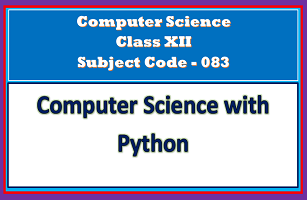 UrbanTution
UrbanTution
Overview
Course Description
Computer Science Tutor for class 12
Once you have completed computer science for class 11 , you must have an idea of python, Computer Systems and Organisation (CSO) ,Society, Law and Ethics and you are ready to learn computer science for class 12.
The syllabus for computer science for class 12 will be covered by the tutor. Urbantution stands behind every tuition. Urbantution will provide you certified computer science tutor for class 12.
If you are looking for computer science tuition online for class 12, we are here to help you. This course is designed for students of class 12. Students will get live one-to-one class for class 12 computer science after booking a tutor from urbantution.
Book a tutor for computer science for class 11
Unit I: Computational Thinking and Programming - 2
● Revision of the basics of Python covered in Class XI.
● Functions: scope, parameter passing, mutable/immutable properties of data objects, passing strings, lists, tuples, dictionaries to functions, default parameters, positional parameters, return values, functions using libraries: mathematical and string functions.
● File handling: Need for a data file, Types of file: Text files, Binary files and CSV (Comma separated values) files.
● Text File: Basic operations on a text file: Open (filenameĀ absolute or relative path, mode) / Close a text file, Reading and Manipulation of data from a text file, Appending data into a text file, standard input / output and error streams, relative and absolute paths.
● Binary File: Basic operations on a binary file: Open (filename absolute or relative path, mode) / Close a binary file, Pickle ModuleĀ methods load and dump; Read, Write/Create, Search, Append and Update operations in a binary file.
● CSV File: Import csv module, functions Open / Close a csv file, Read from a csv file and Write into a csv file using csv.reader ( ) and csv.writerow( ).
● Using Python libraries: create and import Python libraries.
● Recursion: simple algorithms with recursion: print a message forever, sum of first n natural numbers, factorial, Fibonacci numbers; recursion on arrays: binary search.
● Idea of efficiency: performance measurement in terms of the number of operations.
● Data-structures: Lists as covered in Class XI, Stacks Push, Pop using a list, Queues Insert, Delete using a list.
Unit II: Computer Networks
● Evolution of Networking: ARPANET, Internet, Interspace Different ways of sending data across the network with reference to switching techniques (Circuit and Packet switching).
● Data Communication terminologies: Concept of Channel, Bandwidth (Hz, KHz, MHz) and Data transfer rate (bps, Kbps, Mbps, Gbps, Tbps).
● Transmission media: Twisted pair cable, coaxial cable, optical fiber, infrared, radio link, microwave link and satellite link.
● Network devices: Modem, RJ45 connector, Ethernet Card, Router, Switch, Gateway, WiFi card.
● Network Topologies and types: Bus, Star, Tree, PAN, LAN, WAN, MAN.
● Network Protocol: TCP/IP, File Transfer Protocol (FTP), PPP, HTTP, SMTP, POP3, Remote Login (Telnet) and Internet, Wireless / Mobile Communication protocol such as GSM, GPRS and WLL.
● Mobile Telecommunication Technologies: 1G, 2G, 3G, 4G and 5G; Mobile processors; Electronic mail protocols such as SMTP, POP3, Protocols for Chat and Video Conferencing: VoIP, Wireless technologies such as Wi-Fi and WiMax 8
● Network Security Concepts: Threats and prevention from Viruses, Worms, Trojan horse, Spams Use of Cookies, Protection using Firewall, https; India IT Act, Cyber Law, Cyber Crimes, IPR issues, hacking.
● Introduction To Web services: WWW, Hyper Text Markup Language (HTML), Extensible Markup Language (XML); Hyper Text Transfer Protocol (HTTP); Domain Names; URL; Website, Web browser, Web Servers; Web Hosting, Web Scripting Client side (VB Script, Java Script, PHP) and Server side (ASP, JSP, PHP), Web 2.0 (for social networking)
● E-commerce payment transactions using online banking, mobile banking, payment apps and services.
Unit III: Database Management
Database Concepts: Introduction to database concepts and its need.
Relational data model: Concept of domain, relation, tuple, attribute, degree, cardinality, key, primary key, candidate key, alternate key and foreign key;
Structured Query Language:
General Concepts: Advantages of using SQL, Data Definition Language and Data Manipulation Language;
Data Types: number / decimal, character / varchar / varchar2, date; SQL commands: CREATE TABLE, DROP TABLE, ALTER TABLE, UPDATE ....SET...., INSERT, DELETE; SELECT, DISTINCT, FROM, WHERE, IN, BETWEEN, LIKE, NULL / IS NULL, ORDER BY,GROUP BY, HAVING;
SQL functions: SUM ( ), AVG ( ), COUNT ( ), MAX ( ) and MIN ( );
Joins: equi-join and natural join
Interface of Python with an SQL database
- Connecting SQL with Python
- Creating Database connectivity Applications
- Performing Insert, Update, Delete queries
- Display data by using fetchone(),fetchall(),rowcount
5. Suggested Practical List:
Python Programming
● Recursively find the factorial of a natural number.
● Write a recursive code to find the sum of all elements of a list.
● Write a recursive code to compute the nth Fibonacci number.
● Read a text file line by line and display each word separated by a #.
● Read a text file and display the number of vowels/ consonants/ uppercase/ lowercase characters in the file.
● Create a binary file with name and roll number. Search for a given roll number and display the name, if not found display appropriate message.
● Create a binary file with roll number, name and marks. Input a roll number and update the marks.
● Remove all the lines that contain the character `ain a file and write it to another file.
● Write a random number generator that generates random numbers between 1 and 6 (simulates a dice).
● Write a Python program to implement a stack and queue using a list data-structure.
● Take a sample of ten phishing e-mails (or any text file) and find most commonly occurring word(s) 10 Database Management.
● Create a student table and insert data. Implement the following SQL commands on the student table: ALTER table to add new attributes / modify data type / drop attribute UPDATE table to modify data ORDER By to display data in ascending / descending order DELETE to remove tuple(s) GROUP BY and find the min, max, sum, count and average.
● Similar exercise may be framed for other cases.
● Integrate SQL with Python by importing the MySQL module.
6. Project
The aim of the class project is to create something that is tangible and useful using Python / Python and SQL connectivity. This should be done in groups of two to three students and should be started by students at least 6 months before the submission deadline. The aim here is to find a real world problem that is worthwhile to solve. Students are encouraged to visit local businesses and ask them about the problems that they are facing. For example, if a business is finding it hard to create invoices for filing GST claims, then students can do a project that takes the raw data (list of transactions), groups the transactions by category, accounts for the GST tax rates, and creates invoices in the appropriate format. Students can be extremely creative here. They can use a wide variety of Python libraries to create user friendly applications such as games, software for their school, software for their disabled fellow students, and mobile applications, Of course to do some of these projects, some additional learning is required; this should be encouraged. Students should know how to teach themselves. The students should be sensitized to avoid plagiarism and violations of copyright issues while working on projects. Teachers should take necessary measures for this.




